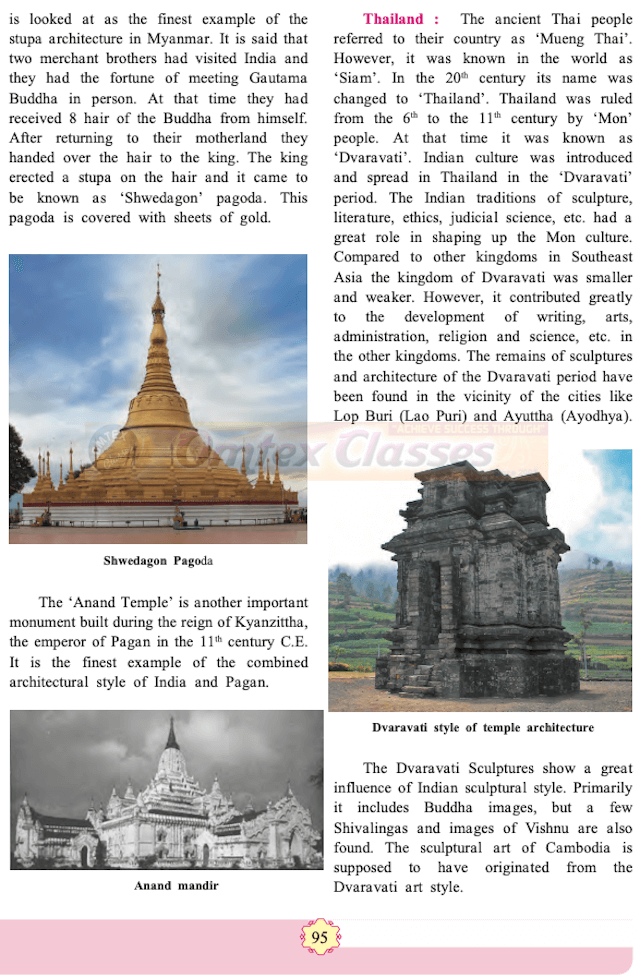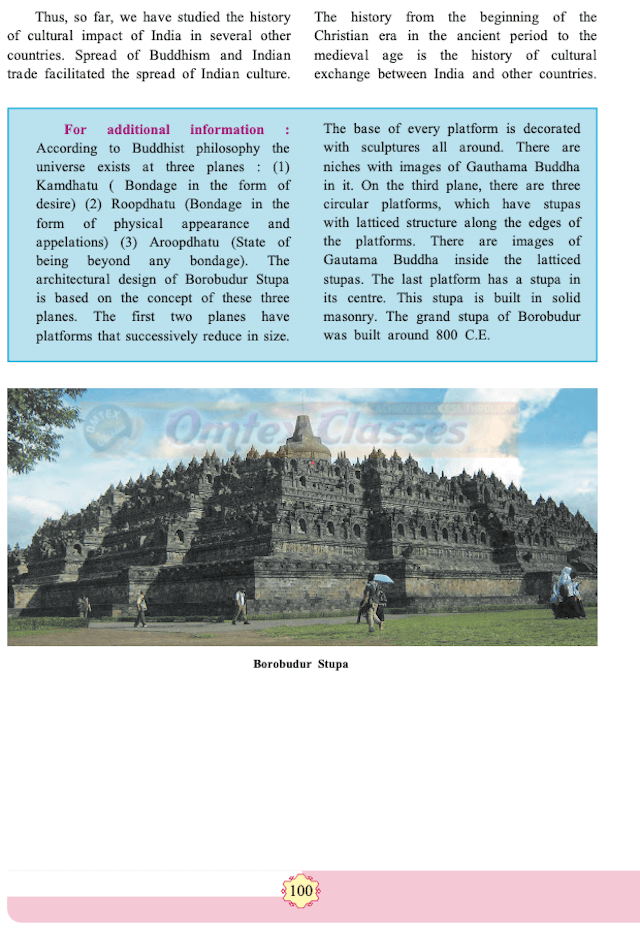Chapter 13: India, Shri Lanka and Southeast Asia
Choose the correct alternative and complete the sentence.
Buddhaghosh was an Indian in ___________ Sri Lanka.
OPTIONS
Thinker
Philosopher
King
Priest
The founder of Pagan empire was ______.
OPTIONS
Kyanzittha
Anwrahta
Ayuttha
Jayavarman
The founder of Pagan empire was ______.
OPTIONS
Kyanzittha
Anwrahta
Ayuttha
Jayavarman
Find the incorrect pair from set B and write the correct ones.
SOLUTION
Write the name.
Son of Emperor Ashoka -'
SOLUTION
Thera Mahinda
Ancient kingdom in Laos -
SOLUTION
Lao Sang
Kingdom of ‘Cham’ people -
SOLUTION
Champa
Last king of Malayu -
SOLUTION
Eskandar Shah
Write short notes on -
Chenla kingdom
SOLUTION
The first kingdom, established in Cambodia was known by the name of 'Chenla'.
The people who established Chenla were known as 'Khmer'.
The influence of Indian culture in Cambodia dates back to the Chenla period.
The kingdom of Chenla was established by Jayavarman II. His capital's name was
'Hariharalaya'.
The kings of Chenla expanded their empire from Vietnam to Myanmar and to China in the north.
After King 'Jayavarman VII' the Khmer empire began to decline.
Visnhu temple at Angkorwat
SOLUTION
The world-famous temple of 'Angkorwat' was built in Yashodharpura, the capital city built by Suryavarman II.
The temple area is about 500 acres, that is about 2 sq. km.
The main entrance is at the west and the temple is surrounded by a moat, which is 200 metres in depth.
Among the sculptural panels on the southeast walls of the temple, the panel of 'Samudra Manthan' is notable. Later, it was turned into a Buddhist temple
Majapahit kingdom
SOLUTION
In the 13th century C.E., in Eastern Java arose a kingdom known as 'Majapahita'.
The name of the founder King of Majapahit was, 'Vijaya'.
He established his supremacy in some of the islands like Java, Bali, and also some other islands and extended the kingdom of Java into an empire.
Champa kingdom
SOLUTION
'Champa' was an ancient kingdom in the coastal region of Vietnam.
Champa was named after the 'Cham' tribe.
The names of the cities in Champa were 'Indrapur', 'Amaravati', 'Vijay', 'Kauthara' and 'Panduranga'.
The city of Vijay was the capital of the Champa kingdom.
The inscriptions of Champa mention the names of its kings and queens and the temples of Hindu deities especially Shiva temples.
Answer the following question in detail.
Explain the spread of Indian culture in Thailand.
SOLUTION
Thailand was referred to as 'Mueng Thai' by the ancient than people. However, it was known as 'Siam' in the world. In the 20th century, its name was changed to 'Thailand'.
Thailand was ruled from the 61hcentury to the 11h century by 'Mon' people. Indian culture was spread at this time.
The Indian traditions of sculpture, literature, ethics, judicial science, etc. had a great role in shaping up the Mon culture.
Dvnravati although smaller and weaker contributed greatly to the development of writing, arts, administration, religion, science, etc. in other kingdoms.
The remains of sculptures and architecture of the period have been found in Lop Buri (Lao Puri) and Ayutthaya (Ayodhya). The sculptures include Buddha images a few Shivalingas and images of Vishnu.
In the 14th century C.E, a new kingdom of Ayutthaya was established in Thailand and the kings of Ayutthaya bore names with the prefix 'Ram'.
Thai Ramayana developed into an independent tradition. It is known as 'Ramakien(Ram Akhyana).
The stories of 'Ramakien' have been preserved in all Thai art traditions including sculpture, folk music, dance, and theatre.
Write about the cultural interrelationship between India and Myanmar.
SOLUTION
'Myanmar' is a neighbouring country of India. It was earlier known as 'Brahmdesh'. In the 2nd century B.C.E. there were city-states known as 'Pyu' in the north and central regions of Myanmar.
Among the new 'Pyu' cities that came into existence at a later period were the cities of' Halin' and 'Shrikshetra' were important.
Shrikshetra was the largest among the 'Pyu' cities. The founders of Shrikshetra belonged to the Shakya clan of Gautam Buddha.
The three Pyu cities of Halin, Beikthano, and Shrikshetra where archaeological excavations were conducted, have brought into light many remains of buildings like stupas, cemeteries, and structures built for water management. The three sites have been declared as World Cultural Heritage sites.
The 'Shwedagon' pagoda built between the 6th - l0th century C.E. at Yongan (Rangoon) is one of the finest examples of stupa architecture in Myanmar.
The 'Shwedagon' pagoda contains the hair of Gautama Buddha. This pagoda is covered with sheets of gold.
The 'Anand Temple' is another important monument built during the reign of Kyanzittha, the emperor of Pagan in the 11th century C.E. It is the finest example of the combined architectural style of India and Pagan.
Balbharati Solutions for History 11th Standard Maharashtra State Board
• Chapter 2: First Cities of India
• Chapter 3: Chalcolithic Villages in India
• Chapter 5: Janapadas and Republics
• Chapter 6: Second Urbanisation in India
• Chapter 7: India and Iran (Persia)
• Chapter 8: India during Mauryan period
• Chapter 9: Post Mauryan India
• Chapter 11: Kingdoms in South India
• Chapter 12: India, Nations in the northwest of the Indian Subcontinent and China
• Chapter 13: India, Shri Lanka and Southeast Asia
• Chapter 14: Delhi Sultanate, Vijayanagar and Bahamani Kingdom
• Chapter 15: India during Mughal period
• Chapter 16: Swarajya to Empire (Maratha period)
.










